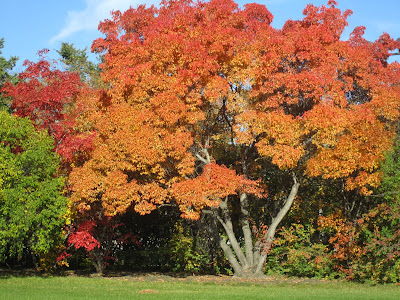"Senescence" refers to the "graduate deterioration of function characteristic of most life forms after maturity." It occurs at the level of the cell and at the level of the organism, though it is believed that cellular senescence underlies the death of the organism. Senescence explains why so many people in industrialized and developed countries now simply die of old age; their cells give up and so do they.
But senescence has its enchanted side, which we are seeing right now, that have more to do with survival than with mortality. All the leaves in our deciduous trees are undergoing senescence--a process scientists don't seem to entirely understand. We know that senescence begins when the chloroplasts break down, so that leaves lose their green colour. But they do this in order to release the chloroplasts' nitrogen back into the tree to prepare it both to survive winter and to flourish in spring. We understand the external causes of senescence--extreme temperatures, drought, lack of sufficient light. But plants are full of hormones that provide internal cues to start the process that we don't entirely understand. The result is that trees turn from their cool green to a wide range of warm colours: yellow, gold, orange, red, purple, rust.
There are so many of us that think of autumn as the real new year: academics and teachers, people who are students or who loved being students, readers eager for the fall offering of new books. Even in retirement, I still think of fall as the beginning of something. Were I thinking carefully about the coming months, this time of year would instill dread, knowing as I do from long experience that as the winter solstice approaches there will be more insomnia; I will lose all belief in myself, particularly as a friend and a writer; and I will struggle valiantly (mostly succeeding) to enter into the spirit of the season. I will also, in Virginia Woolf's words, glory in the "lyrical mood of winter." But as the days grow longer my spirits will lift and I will realize how exhausting the last two months have been. But thinking ahead is entirely intellectual: I don't feel dread or even concern.
Perhaps that is because I think of fall as a season of light. Perhaps on some metaphorical or psychological level, I too am experiencing senescence, storing up thoughts, images, characters, ideas to mull over before the fire during the long nights, making lists of difficult books I want to muse over in the timelessness of insomnia. Perhaps those of us who love fall are, without understanding the process, tuned into trees' survival mechanisms.
But something happens to light (accompanied as it is now by the sound of a trial flight by the Wascana Park geese) when it hits a burning golden tree. Light also seems to have puddled beneath the trees, to be almost springing out of the colder earth. I have a very shady back yard with volunteer Manitoba Maples growing in my own shelter belt on the west side. Suddenly light starts to come through, and the leaves that remain create lacy flickering shadows that dance in the yard. More light comes into the house (especially since I went on a window-washing rampage a couple of weekends ago). I discover light coming into the house differently, sliding in the single living room window that faces south for the first time in months, tossing those leafy shadows on the wooden floor and on the quilt I'm working on.
I've noticed that when you get a group of people together who don't know one another there are two reliable topics of conversation that are both banal and illuminating: animals or pets, and weather. You can learn quite a bit about a person who talks of surviving the west coast rain for five years or the one who teaches a cat to play fetch. I suppose when we talk about pets or animals we reveal our attitudes toward the helpless, the other, the wordless, and our sense of their rights in the world. We're speaking of relationships and principles--as well as about what amuses us. When we talk about weather, though, we talk about our own helplessness, a helplessness that is profoundly social, that many of us share. Weather and moods; seasons and moods. There's an enormous body of literature that attempts to articulate and understand those connections--some of it engaging in the pathetic fallacy, seeing weather as a reflection of human moods, but much of it more honestly trying to see weather as it is.




No comments:
Post a Comment